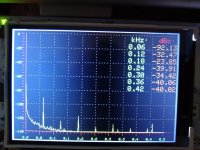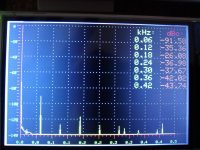what do you guys think is the best regulator in terms of price/performance?
LT3042/LT3045 still seems to be the best performing for around 5/10 euro, tho im wondering if some good regulators exist that cost half as much ?
TPS7A700 is a bit cheaper
LT3042/LT3045 still seems to be the best performing for around 5/10 euro, tho im wondering if some good regulators exist that cost half as much ?
TPS7A700 is a bit cheaper
TPS7A20 is not comparable with LT3042/3045 or TPS7A47/TPS7A33 as output voltage is limited to 5V.he knows about a new one that seems good and much cheaper
It depends on the application. LT3042/LT3045 have lower noise but TPS7A47/TPS7A33 have lower output impedance and higher output voltage/current.what do you guys think is the best regulator in terms of price/performance?
LT3042/LT3045 still seems to be the best performing for around 5/10 euro, tho im wondering if some good regulators exist that cost half as much ?
TPS7A700 is a bit cheaper
NCP731 is indeed cheaper alternative if 150mA output is sufficient.
good find https://www.onsemi.com/download/data-sheet/pdf/ncp731-d.pdf
can these be run in parrallel to increase output current? couldnt find anything in the datasheet about itNCP731 is indeed cheaper alternative if 150mA output is sufficient.
Unless you need a 0.9, 1.8, 3.3 or 5V (and all versions in between) regulator.A yes, that was a downer...
//
Since OP not mentioned desired output voltage or current (it helps to be specific in a hobby that is extremely specific) TPS7A20 possibly may be the right one.
BTW the well performing NCV47551 is 20 mA maximum output current. Once the normal current for a 5 mm LED. Not a powerhouse 😉
https://www.ti.com/lit/ds/symlink/tps7a20.pdf?ts=1737018979285&ref_url=https%3A%2F%2Fwww.ti.com%2Fproduct%2FTPS7A20
The 5V version is called TPS7A2050PDBVR. An attractive name easy to remember 😀
Last edited:
Probably, but quite likely output ballast resistors are needed for current sharing to work properly. See e.g. LT3045 datasheet.can these be run in parrallel to increase output current? couldnt find anything in the datasheet about it
As a minor remark DBV package (SOT-23) has slightly worse performance than the other not-so-diyable packages.The 5V version is called TPS7A2050PDBVR. An attractive name easy to remember
It seems like regulator below 5V has much more applications, producing in large quantity, hence the price is really a bargain for something like TPS7A20 , consider it's performance, 7uV noise, small footprint, 95db psrr, and easy to implement. really love this one.
Replacement for LM317 is very pricy, I guess that's just how the market is.
Replacement for LM317 is very pricy, I guess that's just how the market is.
You can add external pass transistor, see LT3042 datasheet.can these be run in parrallel to increase output current? couldnt find anything in the datasheet about it
These new types of regulators are available from many different manufactureres with very similar specs because there is a specific and large market for them, in smartphones etc.It seems like regulator below 5V has much more applications, producing in large quantity, hence the price is really a bargain for something like TPS7A20 , consider it's performance, 7uV noise, small footprint, 95db psrr, and easy to implement. really love this one.
Yes smart phones and electric cars/photovoltaic stuff drive most new developments. Regulators for low voltages in very small sizes made for RF says it all. Probably SOT-23-5 will be the next to go as it is too large for the minuscule motherboards of today's smart phones. Demand drives development and production (no news).
So audio possibly benefits from those pesky smart phones that seem to be glued to hands 🙂 Most recent discovery was that youth use their 1000 Euro smart phones to play music ... while showering.
Since mains voltage is going up and down per hour due to green stuff we will be forced to use SMPS and local regulators too. It is like that.
So audio possibly benefits from those pesky smart phones that seem to be glued to hands 🙂 Most recent discovery was that youth use their 1000 Euro smart phones to play music ... while showering.
The design of today is based on low cost and hardware turned software designers using SMPS giving dirty voltage and then divided to various clean voltages with several local low power uLDO regulators. Since these ICs are not power-hungry most new regulators are 150 to 300 mA. The old system of having 1 supply voltage at 1A (or more) catering for everything via long PCB tracks is thankfully practically gone. The better system of having multi winding transformers with various voltages going to various regulators (like in old Philips stuff) is unfortunately completely obsolete. This can be proven, just search for a multivoltage transformer. What you will find are 2 x ?V versions.Replacement for LM317 is very pricy, I guess that's just how the market is.
Since mains voltage is going up and down per hour due to green stuff we will be forced to use SMPS and local regulators too. It is like that.
Last edited:
BTW, TI has LT3045-style devices as well, albeit only 5.7Vin max, but higher currents and even better noise (~1nV/rtHz): TPS7A94 (1A) and TPS7A96 (2A). So, for low voltages and higher currents, those are better alternatives at similar cost.
Question is if you really want to power various sections with just 1 expensive regulator (6.5 Euro and 8.95 ex taxes) per rail when you can do it with 50 cent costing lower current regulators per IC/section. From 7 µV to 0.46μV RMS, can we still detect that by ear? Anyway we are free to use what we think we like. Comparing them seems difficult (except for instruments). My question is: when are regulators simply "good enough"?
These were used in a few popular and well liked expensive devices with stellar reviews and herd like following (yes still by many preferred over todays devices that have both excellent numbers and excellent regulators) some years ago:
https://www.st.com/resource/en/datasheet/lfxx.pdf
https://www.ti.com/lit/ds/symlink/lm340.pdf
These were used in a few popular and well liked expensive devices with stellar reviews and herd like following (yes still by many preferred over todays devices that have both excellent numbers and excellent regulators) some years ago:
https://www.st.com/resource/en/datasheet/lfxx.pdf
https://www.ti.com/lit/ds/symlink/lm340.pdf
Last edited:
Sometimes when PCB real-estate and component count is a concern one single regulator might be the better option, together with proper GND/supply planes and distributed capacitance. A single reg also assures synced power-up/-down behavior.Question is if you really want to power various sections with just 1 expensive regulator (6.5 Euro and 8.95 ex taxes) per rail when you can do it with 50 cent costing lower current regulators per IC/section.
From 7 µV to 0.46μV RMS, can we still detect that by ear? Anyway we are free to use what we think we like. Comparing them will be difficult (except for instruments).
Speaking of the latter, for pos+neg regulator duties like typical opamp supplies, I really like the TPS7A39 (150mA, +-33V, moderate noise) for its tracking feature.
IMHO, ultra-low noise (and really low output impedance) likely is only relevant for DAC/ADC reference voltages and oscillator supplies etc. Some very crude amplifier circuit with zero PSRR might also benefit.
For crude and less crude (class D) amplifiers Tombo56's R25 is about the best one can find it seems. Try to find an uLDO with that current and that low noise 😀
Single supply though: https://www.diyaudio.com/community/...ctifier-rf-filter-and-super-regulator.420933/
TPS7A39, made PCBs for it but decided I hate the soldering of that one. So I will have my coming out today. I admit to still use dinosaur XR4195 in new designs. With pleasure!
Single supply though: https://www.diyaudio.com/community/...ctifier-rf-filter-and-super-regulator.420933/
TPS7A39, made PCBs for it but decided I hate the soldering of that one. So I will have my coming out today. I admit to still use dinosaur XR4195 in new designs. With pleasure!
Last edited:
I was thinking of line-level circuits, not power amps.For crude and less crude (class D) amplifiers Tombo56's R25 is about the best one can find it seems.
- Home
- Amplifiers
- Power Supplies
- Low cost and low noise regulator?



